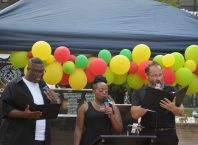
In the wake of last weekend’s white supremacist march in Charlottesville, Virginia, which left a young woman dead and many more injured, cities and towns across the country are asking themselves what, if anything, should be done about their own tributes to the Confederacy. Some of these debates have been going on for years, decades even. The violence in Charlottesville has given them new urgency.
The Southern Poverty Law Center is cataloguing tributes to the Confederacy in public spaces across the U.S., from statues to city seals to the names of parks, schools, and streets. They’ve found 1,500 so far, and they’re far from done. Their database includes four locations in Tyler, and we’ve identified a few others. We wanted to dig into the history of these spots, to understand where they came from, what they stand for, and whether anyone has ever challenged their existence.
Tyler has its own highly visible memorial to the man who lead the Confederate Army, emblazoned across one of its two traditional public high schools. Robert E. Lee High School opened its doors in 1958, a few years after Brown v. Board of Education, the Supreme Court decision that ended racial segregation in public schools and kicked off the Civil Rights era. The late 50’s and ’60s also saw violent backlash to the civil rights movement, as well as a boom of new Confederate statues and other tributes across the South.
Here in Tyler, honoring the Confederacy didn’t end with the new high school’s name. The original school mascot was named the Rebels. The school’s fight song was “Dixie.” Rebel flags flew on school grounds. Some of that ended beginning in 1970, when the now-legendary William Wayne Justice, then district judge for the Eastern District of Texas, ordered Texas to desegregate its schools, a problem that was especially pronounced in East Texas. Texas Monthly explains what happened next:
The good people of Tyler, where Justice was based and where he lived, were not pleased. After the decision forced local high school Robert E. Lee to jettison its Confederate band uniforms and rebel flags, the phone started ringing and the hate mail started coming. Bumper stickers were printed that read “Will Rogers never met Judge Justice.” Carpenters working on his house walked off the job when they found out who owned it, and his wife, Sue, was refused service by local beauticians. “Our social life dwindled,” the judge says in his easy drawl. “But you know, I’d taken an oath to defend and protect the Constitution, and I was going to do my best.”
Band uniforms were changed and the mascot went from the Rebels to the Red Raiders, but the school’s name stayed in place. Today, decades after integration, a third of Robert E. Lee’s students are black. On Monday, Tyler Morning Telegraph’s Cory McCoy reports, some residents plan to propose changing the school’s name at a school board of trustees meeting. There is also a petition in favor of keeping the name; it currently has 5,000 supporters.
Two middle schools in Tyler, James S. Hogg Middle School and Hubbard Middle School, are also named after Confederate soldiers. (Both men were also noted Texas politicians.)
The Southern Poverty Law Center’s database of Confederate markers includes Robert E. Lee High School and Hubbard Middle School, along with two more Tyler spots: Jeb Stuart Drive, and Jeff Davis Drive. James Ewell Brown Stuart, nicknamed for his initials, was among the U.S. Army soldiers who crushed a pre-Civil War anti-slavery uprising led by John Brown at Harper’s Ferry in West Virginia in 1859. He later resigned from the U.S. Army to join the Confederacy. Stuart doesn’t appear to have fought or lived in Texas after joining the Confederacy; it’s unclear to us why a Tyler roadway would be named for him. (If you know, let us know.) Jefferson Davis was, of course, the President of the Confederate States.
Meanwhile, in northwest Tyler, a street named Confederate Avenue runs through the heart of a black neighborhood.
As far as we can tell, none of these names has been seriously challenged in the past.
However, local Confederate memorials haven’t gone entirely without controversy. In 2015, attention was drawn to Confederate memorials at Oakwood Cemetery, which is run by the city. The cemetery contains a large statue honoring 231 Confederate soldiers who, the inscription reads, “at the call of duty fought for the right…and died for their country.” In the past, a Confederate States of America flag flew beneath an American flag at the cemetery, and smaller Confederate battle flags were placed at individual graves. In 2015, a number of battle flags were removed, though it’s not clear by who, and in 2016, the city moved the Confederate flag to a slightly less prominent location. It nows stands a stone’s throw away from a pole displaying the American and Texas state flags, and is on a shorter pole.


Perhaps the most visceral and historically significant trace of Confederate history in Tyler is Camp Ford. The camp was the largest Confederate prisoner of war camp west of the Mississippi. At its height, it held 5,300 captured Union soldiers. Today, the camp features a walking trail with informational plaques, and a picnic spot. Here’s a remarkable account of daily life in Camp Ford from a Boston-born Yankee soldier who spent many months there.
It remains to be seen whether the events in Charlottesville will inspire the same pitch of fury over Tyler’s Confederate monuments and markers that’s currently roiling in places like Durham and Baltimore. In the spring, the city received approval from voters to raise nearly $200 million dollars to rebuild Robert E. Lee High School. The buildings constructed during the 1950’s will cease to exist. Will Tylerites make a big push to overhaul the school’s name, too? What would that look like? Will other Tylerites resist such a change beyond an online petition? We’ll be following this story.
Additional reporting and research by Christopher Groskopf.
Thanks for reading this story. Just one more thing. If you believe in the power of local journalism here in Tyler, I'm hoping that you'll help us take The Loop to the next level.
Our readers have told us what they want to better understand about this place we all call home, from Tyler's north-south divide to our city's changing demographics. Power, leadership, and who gets a seat at the table. How Tyler is growing and changing, and how we can all help it improve. Local arts, culture, entertainment, and food.
We can't do this alone. If you believe in a more informed, more connected, more engaged Tyler, help us tell the stories that need to be told in our community. Get free access to select Loop events, behind-the-scenes updates about the impact and goals of our work, and, above all, a chance to play a part in bringing more fresh, in-depth, unexpected journalism to Tyler.







